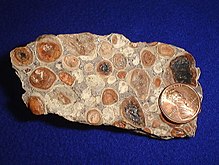bauxite
Bauxite is an aluminum ore that is mainly made up of the aluminum minerals gibbsite (hydrargillite) γ-Al (OH) 3 , boehmite γ-AlO (OH), diaspore α-AlO (OH), and also the iron oxides hematite Fe 2 O 3 and goethite FeO (OH), the clay mineral kaolinite and small amounts of the titanium oxide anatase TiO 2 . A very similar rock, but with a higher content of hematite (i.e. iron), is laterite . Bauxite owes its name to its first place of discovery, Les Baux-de-Provence in southern France, where it was discovered by Pierre Berthier in 1821 .
Emergence
In the geosciences, laterite bauxite (silicate bauxite) are differentiated from karst bauxite (carbonate bauxite). In Europe, the carbonate bauxites, which were discovered early on, are predominantly over carbonate rocks ( limestone and dolomite ), where they were formed by lateritic weathering of clay-rich deposits or clay-rich solution residues. The economic importance of the carbonate bauxites has decreased significantly compared to the laterite bauxites.
The laterite bauxites are found in numerous countries throughout the tropical belt. They were created by lateritic weathering of very different silicate rocks such as granite , gneiss , basalt , syenite , clay and slate . Compared to iron-rich laterite ceilings, bauxites are formed with particularly intensive weathering and increased drainage, which enables kaolinite to dissolve with the formation of gibbsite . The washing out of compounds that do not contain aluminum takes place particularly effectively in tropical climatic zones, as long rainy and dry periods alternate in them. In the deposits, the areas richest in aluminum are often under an iron-rich surface layer. In contrast to the carbonate bauxites , the Al mineral is almost exclusively gibbsite.
Occurrence and extraction
The most important producing countries are Australia, China, Brazil, Guinea, Jamaica and India. Cameroon has the opportunity to catch up with newly discovered large deposits of 500 to 700 million t. Other deposits are found in Russia, Venezuela and Suriname (see table). In Europe, the most important mining sites are in Greece, Hungary and France. From today's point of view, the secured bauxite deposits, which are economically viable, are likely to cover demand in the long term, even if production increases. Bauxite is mainly mined in open-cast mining. In the ideal case, the humus-containing layers of soil released by the mining are initially stored temporarily and later used for recultivation in the interests of sustainable, environmentally friendly development. In 2017 the global production volume was 300 million tons. The largest producers are Australia (83 million tons), China (68 million tons), Guinea (45 million tons), Brazil (36 million tons) and India (27 million tons).
| country | advancement | Reserves |
|---|---|---|
|
|
83.0 | 6,000 |
|
|
68.0 | 1,000 |
|
|
45.0 | 7,400 |
|
|
36.0 | 2,600 |
|
|
27.0 | 830 |
|
|
8.1 | 2,000 |
|
|
5.6 | 500 |
|
|
5.0 | 160 |
|
|
3.9 | 210 |
|
|
3.6 | 1,000 |
|
|
2.0 | 3,700 |
|
|
1.8 | 250 |
| other countries | 11.5 | 4,160 |
| whole world | 300 | 30,000 |
processing
Aluminum is produced from around 95% of the bauxite mined. With a favorable composition, small amounts are used to manufacture aluminum chemicals and abrasives. Low-iron varieties are used as sintered raw materials in refractory materials. During the sintering process ( sintering ), bauxite dehydrates completely and is converted into α-corundum. A by-product of aluminum production is gallium .
To produce metallic aluminum, the bauxite is heated in caustic soda at 150 to 200 ° C in pressure vessels, whereby aluminum dissolves as aluminate and is filtered off from the iron-rich residue ( red sludge ) ( Bayer process ). During cooling and the addition of fine aluminum hydroxide, pure gibbsite separates out of the aluminate liquor as a crystallization nucleus, which is converted into aluminum oxide Al 2 O 3 by annealing . The aluminum oxide is melted with the addition of cryolite as a flux at around 1000 ° C and reduced to metallic aluminum in electrolysis cells with high energy input ( Hall-Héroult process , melt-flow electrolysis ).
With this reduction reaction alone, which takes place at a voltage of around 5 volts with a carbon anode, almost 15 kWh of electricity are required per kg of aluminum and around 1.22 kg of CO 2 are formed. The reprocessing of recycled aluminum then only requires around 5% of this electrical energy.
history
In 1821 the French geologist Pierre Berthier discovered the rock bauxite, which is named after its type of locality , in the southern French town of Les Baux-de-Provence .
In Austria, bauxite was mined near Unterlaussa in the area of today's Kalkalpen National Park for over 80 years until 1964 . There were other deposits in Glanegg in Carinthia and in Großgmain in Salzburg.
See also
literature
- Bardossy, G. (1982): Karst Bauxites. Bauxite deposits on carbonate rocks. Elsevier Sci. Publ. 441 pp.
- Bardossy, G. and Aleva GJJ (1990): Lateritic Bauxites. Developments in Economic Geology 27, Elsevier Sci. Publ., 624 pp. ISBN 0-444-98811-4
- Valeton, Ida (1991): Bauxites and lateritic sediments on unstable coastal platforms. The Earth Sciences; 9, 12; 378-384; doi : 10.2312 / geosciences . 1991.9.378 .
- Prasad, Gisela (1985) The Early Tertiary Bauxite Event. Geosciences in our time; 3, 3; 81-86; doi : 10.2312 / geosciences . 1985.3.81 .
Web links
Individual evidence
- ↑ Bauxite and laterite deposits: residual deposits. In: mineralienatlas.de
- ↑ ERZMETALL 62/2009 No 6, p. 392
- ↑ World mineral statistics - MineralsUK. In: bgs.ac.uk. British Geological Survey, accessed November 26, 2016 .
- ^ US Geological Survey, Mineral Commodity Summaries, January 2018
- ↑ Bauxite mining in Salzburg. Retrieved October 22, 2010 (PDF; 4.5 MB)




